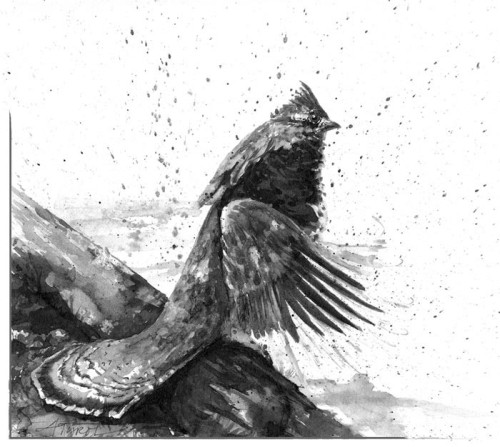
A distant motor thud-thud-thuds as if trying to start, then dies away. The noise repeats, and again dies off. I’ve been fooled by this sound, wondering who could be trying to start a 2-cylinder engine in the middle of the woods. This mechanical noise, of course, is really the drumming of a male ruffed grouse.
People once thought that male grouse struck their wings on a hollow log to produce this low whumping, but better observation revealed something far more astonishing. The bird stands bolt upright on a log, leans back on his tail, and fans his wings vigorously – so fast, in fact, that the wings achieve the same speed as the sound waves generated by their passage through the air. This causes the sound waves to “pile up” into a penetrating shock wave, also known as a sonic boom. For a one-and-a-quarter-pound grouse to exert such force takes strength and perseverance. Novice males have been observed going through all the motions and not producing any sound at all.
With a bit of practice, you too can create a sonic boom. Take a bull whip and flail with all your might. If you’re lucky, you’ll be rewarded with an explosive crack. The whip moves in an up-and-down series of waves along its length that undulate with increasing speed as they approach the tip. By the time the wave motion reaches the whip’s end, the tip is moving at the speed of sound and the crack is its sonic boom.
The rigors of drumming cause a male grouse to lose 10 percent of his body weight during the spring season. So why, one might ask, would a bird go to all this trouble? If you hadn’t already guessed, it’s all to do with mating.
Grouse are secretive forest floor foragers that rely on cryptic coloration and the cover of dense thickets to evade a long list of predators, including foxes, coyotes, fishers, bobcats, owls, and hawks. They live solitary lives for the most part. When it’s time to attract a mate, the male lacks a singing voice, and even if he had flashy colors, they would be lost amid the vegetation. However, the shock waves of drumming carry effectively through the forest.
Drumming advertises the male’s presence to female grouse. It is also a territorial announcement that tells other males, “stay away - this territory is taken!” In good habitat, male grouse tend to space themselves so each defends an area of about 10 acres, allowing them sufficient resources to survive. This space overlaps the territories of several females that risk their safety in walking some distance to investigate the drumming males. Occasionally, less successful young males have been observed drumming at the edges of a dominant male’s performance area, perhaps to take advantage of the influx of females. However, ruffed grouse do not form the communal display areas (or leks) characteristic of prairie grouse.
Loud self-advertisement is a risky business for a bird with many enemies. The male grouse chooses his drumming site with care to reduce the chances of predation. His performance stage, be it a log (ideally 15 inches high and 20 to 40 feet long) or a rock, is situated under overhead branches to deter raptors. At one end of the stage is some form of escape cover, a root mass, some brush, or a stump. The stage is usually in an area with a relatively unobstructed view for 50 feet or more, so sneaking predators can be spotted. Thus, a good drumming site is hard to find and once a male grouse locates one, he tends to use it for life – that is, about three or four years.
Mating, the reason for all this sound and fury, takes place in a matter of seconds after a brief courtship in which the male struts and fans out his tail and neck ruff. The female then disappears back into the thickets, shouldering the perilous task of incubating the eggs on the ground and raising the brood alone. If you see a female grouse trailing her wing as if injured in the coming months, she’s bravely trying to lure you away from her chicks.
The male continues to drum for several weeks to attract more females and mate with them. In autumn, he drums again, this time to defend his territory from dispersing males.
To encourage grouse, encourage aspen. Dense expanses of aspen saplings are preferred cover for grouse broods, while stands of poles, eight to ten inches in diameter are perfect cover for drumming males. Mature aspens provide buds and catkins, a critical winter food of grouse. To keep up the supply of aspen, a short-lived pioneer species, forests need a regime of periodic disturbance. Forest fires, windstorms, and chainsaws can create ideal grouse habitat.


Discussion *